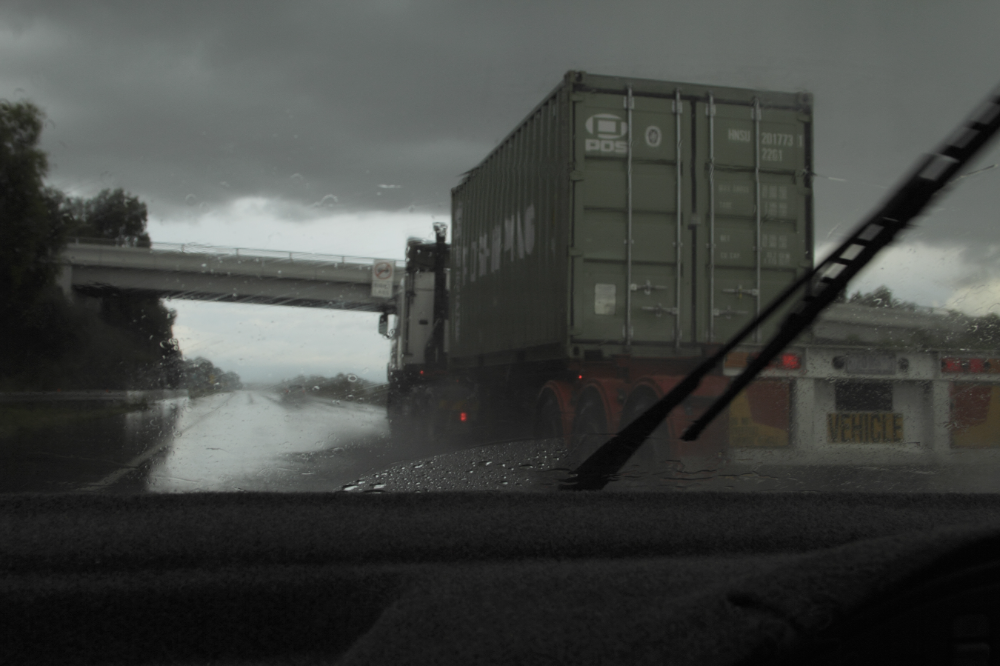
When Oklahoma Weather Turns Deadly: Understanding Semi-Truck Accidents
One moment the road is clear, and the next you’re facing a jackknifed semi-truck sliding across slick pavement. Weather conditions can transform Oklahoma highways from safe transit routes into hazardous zones, particularly for the massive commercial vehicles that transport goods across our state.
When severe weather contributes to a semi-truck accident, victims often face devastating injuries, complex liability questions, and uncertain paths to compensation. The aftermath can be overwhelming—medical bills pile up, work becomes impossible, and insurance companies offer settlements that rarely reflect the true cost of your suffering. Understanding how weather factors into these accidents isn’t just academic—it could be crucial to securing the semi-truck injury compensation you deserve.
When the weather takes a turn for the worse, don’t let it cloud your path to justice. At Cain Law, we’re here to help you navigate the stormy waters of semi-truck accident claims. Reach out to us at 855-759-7874 or contact us today to ensure your rights are protected and your compensation is fair.
Oklahoma’s Legal Framework for Weather-Related Semi-Truck Accidents
 Oklahoma law holds commercial drivers to a higher standard of care than regular motorists, especially during adverse weather conditions. Under Oklahoma transportation regulations, commercial drivers must exercise “extreme caution” when hazardous conditions like snow, ice, sleet, fog, or rain affect visibility or traction. This legal standard means trucking companies and their drivers can still be held liable even when weather played a role in the accident.
Oklahoma law holds commercial drivers to a higher standard of care than regular motorists, especially during adverse weather conditions. Under Oklahoma transportation regulations, commercial drivers must exercise “extreme caution” when hazardous conditions like snow, ice, sleet, fog, or rain affect visibility or traction. This legal standard means trucking companies and their drivers can still be held liable even when weather played a role in the accident.
The Federal Motor Carrier Safety Administration (FMCSA) regulations, which apply in Oklahoma, require commercial drivers to reduce speed and even cease operations when conditions become sufficiently dangerous. Despite these clear legal standards, many victims don’t realize that “bad weather” isn’t a free pass that automatically absolves trucking companies of responsibility. Truckers are professionally trained to handle various weather conditions, and their failure to adjust to these conditions appropriately can constitute negligence under Oklahoma law. This creates a foundation for pursuing semi-truck injury claims even when the weather was a contributing factor.
Critical Timeline for Weather-Related Semi-Truck Accident Claims
Understanding the timeline of a weather-related semi-truck injury claim is essential for protecting your rights. After all, weather related evidence can strengthen your Tulsa accident claim. Oklahoma’s legal process follows specific timeframes that can significantly impact your ability to recover compensation. Weather evidence is particularly time-sensitive—road conditions change, weather data may become harder to access, and witness recollections fade. Here’s what you need to know about navigating this timeline effectively:
- Oklahoma’s statute of limitations gives you just two years from the date of the accident to file a lawsuit, though it’s advisable to begin the legal process much sooner while evidence is fresh.
- Weather-related evidence, including local precipitation reports, road maintenance records, and traffic camera footage, must be preserved quickly, often within 30-60 days before they’re routinely deleted or become unavailable.
- Insurance companies typically make initial settlement offers within 30-90 days—offers that rarely account for the complex liability factors in weather-related accidents and often undervalue long-term medical needs.
- A thorough accident reconstruction incorporating weather data typically takes 3-6 months to complete, but is often essential for establishing how a professional driver should have responded to the specific conditions.
Securing Fair Compensation After Weather-Influenced Semi-Truck Crashes
Achieving fair compensation after a weather-related semi-truck accident requires a nuanced approach that balances meteorological evidence with legal standards of care. At Cain Law, we understand that weather conditions create a complex liability landscape that demands thorough investigation beyond typical accident claims. Rather than accepting the common defense that “the weather caused the accident,” our approach focuses on how professional drivers should respond to adverse conditions.
Semi-truck injury compensation in Oklahoma should account for immediate medical expenses, ongoing rehabilitation, lost income, diminished earning capacity, and pain and suffering. The key to maximizing your recovery lies in documenting how the driver’s response to weather conditions deviated from professional standards. This might include proving they drove too fast for conditions, failed to increase following distance, or ignored weather advisories. By precisely documenting these deviations from professional standards, we’ve helped clients transform what insurance companies initially dismissed as “unavoidable weather accidents” into substantial settlement offers that truly reflect the impact these injuries have had on their lives.
Weather Phenomena That Most Significantly Impact Semi-Truck Safety in Oklahoma
Oklahoma’s diverse climate creates several weather conditions that dramatically increase the risk factors for semi-truck accidents. Understanding these specific weather phenomena can help establish liability in your case and explain why a professional driver should have taken different actions. Oklahoma experiences several distinct weather patterns that create uniquely hazardous conditions for commercial vehicles due to their size, weight, and handling characteristics. These weather conditions require specific adaptations from professional drivers that, when neglected, create clear liability despite the challenging environment.
Sudden Downpours and Flash Flooding
Oklahoma’s rapid-forming thunderstorms can reduce visibility to near zero within moments and create hydroplaning conditions that are particularly dangerous for heavy vehicles. Commercial drivers are trained to recognize the signs of approaching storm cells and should reduce speed well before encountering these conditions. When a semi-truck continues at highway speeds despite visible storm conditions ahead, this represents a clear deviation from professional standards.
We’ve observed that in many cases, commercial drivers face pressure from dispatchers to maintain schedules despite deteriorating conditions, creating a dangerous prioritization of delivery timelines over safety. This pressure often appears in electronic communications that can be recovered during litigation, providing crucial evidence that weather alone didn’t cause the accident, but corporate policies encouraging unsafe practices did.
How Semi-Truck Equipment Failures Amplify Weather Dangers
Weather conditions expose and amplify existing maintenance issues in commercial vehicles, creating a dangerous combination of environmental hazards and mechanical failures. When investigating semi-truck injury claims, it’s essential to examine how equipment condition interacts with weather to cause or worsen an accident. Trucking companies have specific maintenance obligations under both Oklahoma state law and federal regulations that become even more critical during adverse weather. Properly functioning systems like antilock brakes, tire tread, windshield wipers, and lighting are the difference between a professional driver safely navigating challenging conditions and causing a catastrophic incident involving truck accident injuries.
Tire Condition and Weather-Related Accidents
Tire maintenance becomes critically important during adverse weather conditions. Commercial trucks operating with worn tires lose significant traction in wet or icy conditions, dramatically increasing stopping distances and reducing stability during evasive maneuvers. Under FMCSA regulations, commercial vehicle tires must have a minimum tread depth of 4/32 inches on steering axles and 2/32 inches on all other axles.
Post-accident investigations often reveal that companies have been operating with tires below these minimums to delay replacement costs. Improper tire inflation also significantly affects handling in adverse conditions—underinflated tires increase hydroplaning risk while overinflated tires reduce traction on slippery surfaces. A comprehensive investigation should include tire condition documentation and maintenance records review to establish whether equipment failures, not just weather, contributed to the accident circumstances.
The Intersection of Driver Fatigue and Weather Challenges
Weather-related driving demands heightened attention, quicker reactions, and better judgment—all cognitive functions that deteriorate with fatigue. For semi-truck drivers facing Oklahoma’s unpredictable weather patterns, fatigue creates a particularly dangerous scenario where reaction times are already compromised when they need to be at their sharpest. The combination of driver fatigue and adverse weather conditions creates a particularly dangerous scenario on Oklahoma highways. When pursuing semi-truck injury compensation, examining how these factors intersect can reveal significant liability that might otherwise be attributed solely to “bad weather.” All of this is often taken into account when determining who is liable in a truck accident.
Hours-of-Service Violations During Weather Events
Federal regulations limit commercial drivers to 11 hours of driving after 10 consecutive hours off duty, but these rules are routinely violated, especially when weather delays create pressure to make delivery deadlines. Electronic logging devices (ELDs), now required in commercial vehicles, can provide evidence of whether a driver was operating beyond legal limits when they encountered challenging weather conditions.
When driver fatigue combines with weather challenges, the resulting impairment in judgment often manifests as poor speed management, inadequate following distance, or failure to recognize changing road conditions. A thorough investigation should include analysis of driver logs, delivery schedules, and communications between the driver and their company to determine whether fatigue amplified the weather-related risks and contributed to the accident circumstances.
Documenting Weather Conditions for Your Semi-Truck Injury Claim
Successfully incorporating weather conditions into your semi-truck injury claim requires specific types of evidence and documentation that many victims don’t realize they should preserve. Weather conditions are fleeting, making immediate and thorough documentation essential to establishing how they contributed to the accident and how a professional driver should have responded. The strength of your claim often depends on how effectively you can reconstruct the exact conditions at the time of the accident, which requires more than general weather reports for the day in question.
Weather Evidence That Strengthens Your Claim
Building a strong semi-truck injury lawsuit requires specific weather-related evidence that establishes both the conditions at the time of the accident and how they should have affected professional driver behavior. This evidence can come from numerous sources that many victims don’t immediately consider. National Weather Service data can provide hour-by-hour precipitation amounts, wind speeds, and visibility reports specific to your accident location. Local traffic cameras often capture real-time road conditions, though this footage is typically preserved for only short periods unless specifically requested.
Witness statements specifically addressing weather conditions and how other vehicles were responding can establish whether the semi-truck driver was operating appropriately for the conditions. Road maintenance records can reveal whether highways were treated for ice or if drainage issues contributed to flooding. Professional meteorological officials can analyze this data to create detailed reconstructions of conditions at the exact time and location of your accident, creating powerful evidence that specifically addresses how a reasonable professional driver should have modified their behavior.
Frequently Asked Questions
1. Can I still receive semi-truck injury compensation in Tulsa if bad weather contributed to my accident?
Yes, you can still pursue compensation even when the weather is a factor. Oklahoma law holds commercial drivers to a higher standard of care that requires them to adjust their driving to weather conditions. If a semi-truck driver failed to reduce speed, increase following distance, or take other reasonable precautions during adverse weather, they may still be liable for your injuries. The key is demonstrating that a professional driver should have taken different actions despite the challenging conditions. An experienced Tulsa semi-truck injury attorney can help establish this crucial distinction between weather being a factor versus being the sole cause of the accident.
2. What types of weather conditions most commonly lead to semi-truck injury lawsuits in Oklahoma?
In Oklahoma, the weather conditions most frequently involved in semi-truck injury claims include sudden thunderstorms with heavy rainfall, winter precipitation (ice and snow), dense fog, particularly in river valleys, and high crosswinds that affect trailer stability. These conditions are especially dangerous for semi-trucks because of their weight, high center of gravity, and longer stopping distances. Professional drivers receive specific training on handling these conditions, including when to reduce speed or pull over entirely. When drivers fail to apply this training, they create liability for injuries that result—even when weather creates challenging driving conditions.
3. How long do I have to file a Tulsa semi-truck injury claim involving weather-related factors?
Oklahoma’s statute of limitations gives you two years from the date of the accident to file a lawsuit for injuries resulting from a semi-truck accident, regardless of whether weather was involved. However, weather-related evidence is particularly time-sensitive and may disappear much sooner. Traffic camera footage, trucking company communications about weather conditions, and witness memories all deteriorate quickly. To preserve this crucial evidence, it’s advisable to consult with a Tulsa semi-truck injury attorney as soon as possible after the accident—ideally within days or weeks rather than months. They can handle tricky parts of the injury claim process, such as contacting the insurance company of the other driver.
4. What damages can I recover under Oklahoma semi-truck injury laws when weather contributed to my accident?
In Oklahoma, you can recover the same categories of damages in weather-related semi-truck accidents as in any other commercial vehicle crash, provided you can establish the driver’s negligence despite the conditions. These damages typically include medical expenses (both current and future), lost wages, reduced earning capacity, property damage, and pain and suffering. In some cases involving reckless behavior during severe weather, punitive damages may also be available. The weather’s contribution doesn’t reduce your potential compensation if you can show the driver failed to exercise appropriate caution for the conditions.
5. How do insurance companies typically handle Tulsa semi-truck injury claims involving adverse weather?
Insurance companies often use weather conditions to attempt to minimize their liability, arguing that the accident was “unavoidable” due to “acts of God.” They may offer quick, low settlements, hoping you’ll accept before fully understanding how professional standards require the driver to respond to those conditions. They may also claim contributory negligence, suggesting you were partially responsible for driving in the same conditions. Countering these tactics requires knowledge in both Oklahoma transportation laws and professional trucking standards. A Tulsa semi truck injury attorney can help demonstrate that commercial drivers have specific obligations during adverse weather that go beyond those of ordinary drivers and that the failure to meet these standards—not the weather itself—caused your injuries.
Work with a Semi-Truck Injury Lawyer
Navigating the aftermath of a weather-related semi-truck accident requires legal knowledge that bridges meteorology, commercial transportation regulations, and Oklahoma injury law. When selecting an attorney to handle your case, look for someone who understands how weather evidence interacts with the higher standard of care required of commercial drivers. Your attorney should have experience specifically with semi-truck accidents rather than just general auto accidents, as the regulatory framework, insurance considerations, and liability questions differ significantly.
They should also have relationships with accident reconstruction officials who can incorporate weather data into their analysis, meteorological officials who can testify about conditions, and medical professionals who understand the unique injury patterns that result from commercial vehicle impacts. With the right legal representation, what might initially appear to be “just a weather-related accident” can be properly recognized as what it often truly is: a preventable tragedy caused by a professional driver’s failure to respect and adapt to the power of Oklahoma’s weather conditions.
Don’t let the stormy weather leave you in the dark about your rights. At Cain Law, we’re ready to help you navigate the complexities of semi-truck accident claims. Give us a call at 855-759-7874 or contact us today to ensure your path to fair compensation is clear and straightforward.

